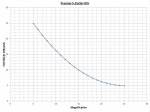I'm looking for a new scope to replace my NXS 8-32x56 as the field of view (FOV) on low power is far too small for the type of shooting that I do these days. I've created a graph to try and get a visual representation of all the models that I'm considering and their FOV's at different magnification settings. (see attachment)
All the data is from manufacturer websites and has not been tested in any way. Could anyone with a bit more experience say if what the graph shows is anywhere near the truth i.e. dose the FOV reduce in a linier fashion as magnification increases?
Cheers.
JWEM
All the data is from manufacturer websites and has not been tested in any way. Could anyone with a bit more experience say if what the graph shows is anywhere near the truth i.e. dose the FOV reduce in a linier fashion as magnification increases?
Cheers.
JWEM



